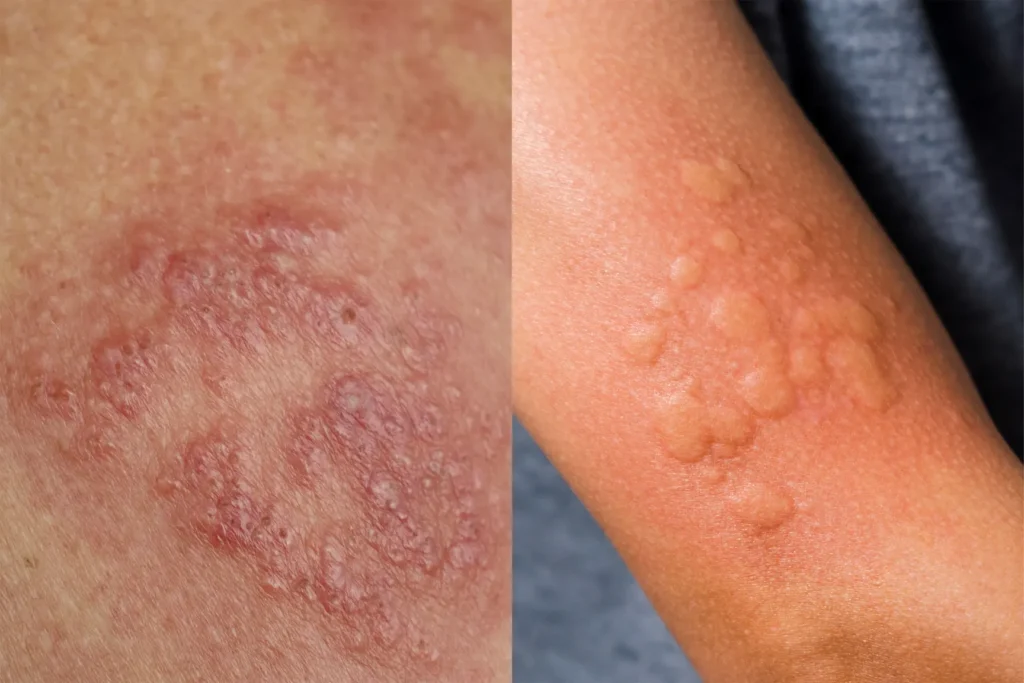Sometimes it’s just a few itchy bumps. Other times, it looks like a swarm of angry mosquitoes chose you as their favorite buffet. Whether you’ve dealt with hives before or they’re suddenly ruining your evening, one thing’s certain: they can be uncomfortable, unexpected, and exhausting.
This guide walks you through what’s going on under your skin, what can help, and when to get medical attention. No scare tactics—just real, useful info.
🔬 What Are Hives, Really?
Hives (or urticaria) are a type of immune response where your body, often without clear reason, releases histamine. This chemical dilates blood vessels and causes swelling, redness, and intense itching.
They’re not contagious. They’re not dangerous in most cases. But they can look alarming—especially if you develop swelling around the lips, eyelids, or tongue.
⚡ What Can Trigger Hives?
Sometimes the cause is obvious. Other times, it’s a mystery. The most common triggers include:
- Medications – especially antibiotics (like amoxicillin) or NSAIDs
- Foods – nuts, shellfish, strawberries, eggs
- Physical stimuli – heat, cold, sun, pressure, sweat
- Infections – colds, strep throat, COVID
- Emotional stress
- Contact allergens – latex, cosmetics, detergents
In some cases, no clear cause is ever found. This is called idiopathic hives.

🧪 How to Recognize Hives
Typical signs:
- Sudden red or pink welts (that may join into larger patches)
- Intense itching
- Swelling in certain areas like lips or eyelids
- “Migrating” rash that appears and fades in different spots
- Bumps disappear after 24 hours in one area but may reappear elsewhere
🚨 If you experience difficulty breathing, throat tightness, hoarseness, or dizziness—seek emergency help immediately. This could be a sign of anaphylaxis.
💊 What Helps Relieve Hives?
1. Modern Over-the-Counter Antihistamines
- Cetirizine – fast-acting, common choice
- Loratadine – gentle, often used in children
- Fexofenadine – strong and usually non-drowsy
- Desloratadine – effective for chronic cases
📌 These work best when taken as soon as symptoms begin. Some can also be used preventively if your triggers are known.
2. Topical Relief
- Cooling gels (e.g., aloe vera, antihistamine creams)
- Hydrocortisone 1% cream – for small inflamed areas
- Cold compresses – chilled towel or ice pack wrapped in cloth
3. What to Avoid
- Alcohol
- Tight clothing
- Hot showers or sweating
- Scratching (it only makes it worse)
🧭 When to See a Doctor
| Symptom | Why It Matters |
|---|---|
| Swelling of tongue, lips, throat | Could indicate a life-threatening reaction (anaphylaxis) |
| Hives last more than 3–5 days | Could signal chronic or autoimmune issues |
| Fever or joint pain | May point to an underlying infection or immune disorder |
| Rash after medication | Must be reported and recorded for future safety |
💉 What Treatment Will You Get at the ER?
Medical professionals typically use:
- Corticosteroids (e.g., Solu-Medrol, Prednisone) – to reduce inflammation
- Stronger antihistamines (IV or injected) – like cetirizine or diphenhydramine
- Epinephrine + oxygen – in cases of breathing difficulties
You may also receive IV fluids for systemic support.
🧬 What If Hives Keep Coming Back?
If hives persist beyond 6 weeks, you may have chronic urticaria, and should see an allergist or immunologist. Expect:
- Blood tests
- Skin prick testing
- Possibly autoimmune screening
In stubborn cases, biologic therapy (like omalizumab) may be recommended.
🌍 Keep This in Mind for the Future
- Write down the medication name and the date of reaction
- Take photos of the rash for your medical file
- Consider a medical alert card or allergy bracelet
- When traveling, carry antihistamines and your diagnosis in English
Final Thoughts
Hives are common, but that doesn’t mean they’re harmless. Most cases respond well to antihistamines and a calm approach. The real danger is missing serious symptoms—or not learning from what triggered them.
When your skin speaks, it pays to listen.











